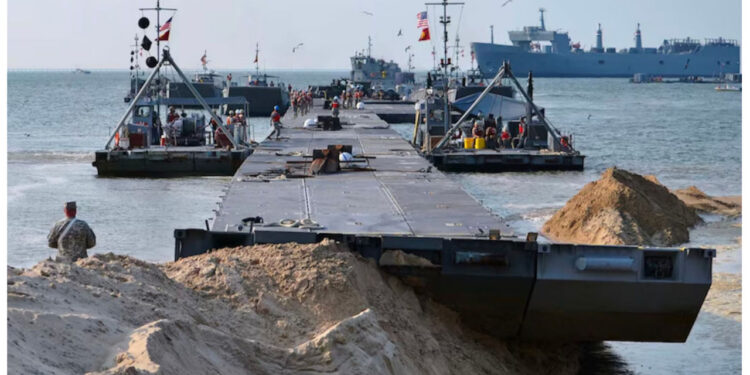Marine traffic websites indicate that the USNS Roy Benavidez is currently active near the Gaza coast. It has commenced the construction of a floating platform that will be used to unload supplies from civilian cargo ships. Other vessels that will assist the floating pier are currently on their way to Gaza from Crete, Greece. These ships had previously docked in Crete after completing a trans-Atlantic journey to the eastern Mediterranean.
According to a senior U.S. military official, the construction of the JLOTS landing platform off the shore of Gaza began on Thursday.
According to the official, the delivery of humanitarian assistance to Gaza from the sea is scheduled to commence in early May. Once operational, the JLOTS pier will be capable of accommodating approximately 90 trucks per day, with the potential to rapidly increase to 150 trucks for the transport of humanitarian aid.
According to the official, the increase in life-saving aid from the sea is a significant addition in terms of throughput.
Humanitarian assistance from aid agencies will undergo screening, palletization, and preparation for delivery in Cyprus, located 200 miles away from Gaza. The objective is for this assistance to reach the JLOTS platform and floating causeway.
According to the senior U.S. military official, the aid will be unloaded at a floating platform situated several miles offshore. Subsequently, smaller watercraft will transport five trucks each, which will then be offloaded onto a floating causeway or pier anchored to the shore.
According to the official, the trucks will transport their cargo to a secure area for future distribution. This process will be repeated regularly as they travel back and forth to the floating platform.
The truck drivers will not consist of U.S. military personnel or American contractors, according to the official. Instead, they will be individuals from an undisclosed country who are not Americans and will have their own security.
According to an official, the British naval ship Cardigan Bay will serve as the living and sleeping quarters for the hundreds of U.S. soldiers and sailors responsible for constructing and maintaining the JLOTS system. The ship will be stationed several miles offshore.
The Biden administration has consistently emphasized that there will be no deployment of U.S. troops on the ground. However, this limitation does not extend to the other personnel involved in the JLOTS mission, who will be actively assisting in Israel.
Without any U.S. forces present to secure the floating platform to the beach in Gaza, an American Army engineering unit collaborated with an equivalent IDF unit to provide them with training on how to anchor it on the beach from the very beginning. The training took place on an Israeli beach located “just up the coast,” as stated by the senior military official.
U.S. military personnel will join forces with Israeli Defense Forces personnel at a coordination cell based at Hatzor airbase in Ashdod, Israel. This collaborative effort is being overseen by a highly-ranked U.S. general, showcasing the strong partnership between the two nations.
Ryder emphasized that this took place before any U.S. forces began transporting anything. He clarified that there is no specific U.S. equipment in the marshaling yard, which will be used for distributing aid received through JLOTS.
According to the senior military official, the mortar attack has been evaluated as unrelated to the JLOTS mission. He also mentioned that the security measures in the affected area will be significantly strengthened once it becomes operational.
According to a senior U.S. military official, ensuring force protection remains the top priority. The official revealed that Israel has dedicated a brigade consisting of thousands of soldiers, along with Israeli Navy ships and aircraft, to safeguard American forces both at sea and at the landing and distribution centers onshore.
The chosen location for the floating platform has been deemed secure enough to carry out the mission, according to a U.S. military official. However, the final decision on its use will ultimately rest with the commander of U.S. Central Command.










